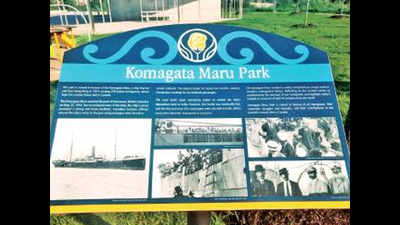- News
- City News
- ludhiana News
- Park named after Komagata Maru tragedy opens in Canada’s Brampton city
Trending
This story is from June 24, 2019
Park named after Komagata Maru tragedy opens in Canada’s Brampton city
In a tribute to the 105-year-old Komagata Maru tragedy, a public park named after the ship was opened at Brampton city in the Ontario province of Canada on Saturday. The park was set up in honour of the immigrants who were on board the ship in 1914.

The park was set up in honour of the immigrants who were on board ship Komagata Maru in 1914
BATHINDA: In a tribute to the 105-year-old Komagata Maru tragedy, a public park named after the ship was opened at Brampton city in the Ontario province of Canada on Saturday. The park was set up in honour of the immigrants who were on board the ship in 1914. This is claimed to be the first Canadian commemoration of Komagata Maru outside of British Columbia province.The park has been set up with the persistent efforts of Brampton city regional councillor Gurpreet Singh Dhillon.
Earlier, the Canadian postal department had issued a postage stamp in on May 6, 2014, to mark the centenary of the incident.
“Brampton Mayor Patrick Brown opened the Komagata Maru park. He also paid tributes to those who were on the ship. Three descendants of those on the ship also participated in the opening,” said Dhillon.
Komagata Maru, a Japanese steamship hired by influential Sikh Baba Gurdit Singh, was boarded by 376 Indians and set sail for Canada in 1914, transporting immigrants largely from Punjab to Canada. The Canadian officials had denied entry to passengers at Vancouver port citing Canada’s Continuous Passage regulation, which was brought into force in 1908 in an effort to curb Indian immigration to Canada and the ship was sent back. When the ship reached Budge Budge port near Kolkata, the British government had ordered firing on passengers.
Earlier, the Canadian postal department had issued a postage stamp in on May 6, 2014, to mark the centenary of the incident.
“Brampton Mayor Patrick Brown opened the Komagata Maru park. He also paid tributes to those who were on the ship. Three descendants of those on the ship also participated in the opening,” said Dhillon.
Komagata Maru, a Japanese steamship hired by influential Sikh Baba Gurdit Singh, was boarded by 376 Indians and set sail for Canada in 1914, transporting immigrants largely from Punjab to Canada. The Canadian officials had denied entry to passengers at Vancouver port citing Canada’s Continuous Passage regulation, which was brought into force in 1908 in an effort to curb Indian immigration to Canada and the ship was sent back. When the ship reached Budge Budge port near Kolkata, the British government had ordered firing on passengers.
According to documents, the 376 Indians who boarded the ship from various places included 340 Sikhs, 24 Muslims and 12 Hindus. The ship had reached Vancouver on May 23, 1914 after passing through Hong Kong and Shanghai. Only 20 passengers who succeeded in establishing their resident status were allowed to disembark and the ship was made to return to India on July 23 after remaining at Vancouver harbour for exactly two months. It reached near Calcutta on September 27 and the British forces had killed many of the passengers at Budge Budge port and had imprisoned many others.
End of Article
FOLLOW US ON SOCIAL MEDIA











